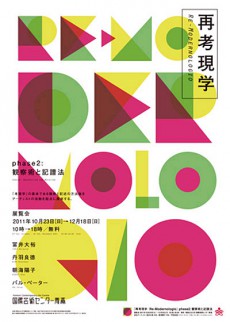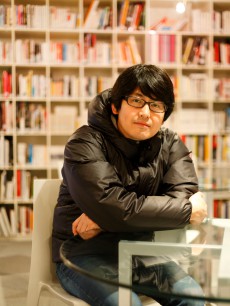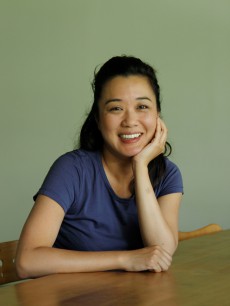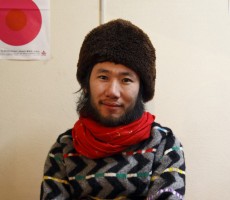
「再考現学 / Re-Modernologio」phase2 : 観察術と記譜法
2011年10月23日(日)~12月18日(日) 10:00 - 18:00/無料

「考現学」の基本である観察と記述の方法論をアーティストの活動を起点に探求する。
今年度ACACでは青森県出身の建築家今和次郎が提唱した「考現学」をキーワードに、現代の社会構造や生活文化、地域の日常生活と芸術の関係のあり方をアーティストの創作活動を通じて探求し再考する展覧会『再考現学』を2011年7〜9月、10〜12月、2012年1〜3月の3期に分けて開催します。第2期となるphase2のテーマは「観察術と記譜法(きふほう)」です。今和次郎は当時の社会や生活空間を非常に注意深く様々な角度から眺め、それをドローイングによりとても丁寧に記述していきました。 phase2に参加するアーティストに共通するのは、みな鋭い観察力をもって現在の状況や対象とするものや人の様子を注視し、それを変換、あるいはそれに対してアクションを起こす、または対話をするように記述し定着する独自の表現手法を備えていることです。冨井大裕(とみいもとひろ)は誰もが見覚えのある日用品などの「もの」が元来備えている機能や意味をいちど剥奪し、それをそのもの自体の色やかたちにまで還元し組み合わせることで彫刻を実現します。丹羽良徳は通常は人が気にもとめないような状況や、彼が置かれた世界で見えてくる違和感に敏感に反応し、そこに異質な行為を挿入することで生じる緊張した状況に自らを置くことをパフォーマンスとして記述していきます。そして朝海陽子はなんらかの事柄に没頭している様々な人の姿や振舞いを限られた時間で彼らと対話するなかでその空間に没入し、瞬間を捉え写真として定着していきます。また、同時期にはルーマニアより美術家で教会のフレスコ画などの修復家としても活動するパル・ペーターが来青し、同テーマのもとで野外彫刻作品の制作を実施します。最終的な作品の表現手法は千差万別ですが、自身の探求するものへの独自の観察力の鋭さと、捉えたものをかたちにする一貫した記譜法には、非常に興味深いものがあります。 今和次郎は、やはり独自の観察力で当時の状況を多角的に捉え、とても特徴あるドローイングという記譜法によりそれを定着させていきました。観察と記述という考現学の基本的なメソッドを、各アーティストの制作スタイルになぞらえて考察することで、世界の見方や記述(定着)の仕方を探求していきます。 ※「考現学」とは:青森県出身の建築家今和次郎(1888−1973)が提唱した学問。現代の社会現象を場所・時間を定めて一斉に調査・研究し、世相や風俗を分析・解説しようとする学問。ドローイングを用いたフィールドワークを特徴とし、のちの生活学や風俗研究の先鞭となった。

冨井大裕(TOMII Motohiro)

発見し、組み合わせる「彫刻」
冨井大裕は、既製品を組み合わせた作品を「彫刻」として発表しています。彼は既製品が持つ機能に着目し、それを取り出すことから制作の糸口をつかみます。しかし結果的に私達が目にする彼の作品は、不思議なことにモノが持つ機能よりもモノの形や色の面白さや美しさが際立つようになります。 本展では、ACACの中で彼が発見した既製品の組み合わせを展示室に配置しています。一見作品とは思えない数々の「モノ」を見て、なぜこれが芸術作品なのかと戸惑う人の方が多いかもしれません。しかし、共に展示してある彼の書いた指示書を読むと、それはよく考えられた巧妙な組み合わせだということが分かります。私達が何気なく置いたり並べたりするモノの組み合わせの面白さを発見するアーティストの目線、そして「ただのモノ」がアーティストによって展示室に並べられることでどう見えるのかという自分自身の目線の変化、という2種類の「ものの見方」を楽しめることでしょう。
http://tomiimotohiro.com/
丹羽良徳(NIWA Yoshinori)

「行為」で表現する
丹羽良徳は、社会の中で人々が当たり前だと考えていたり、見落としていたりする常識や共通の認識、あるいは社会の体制などに目を向け、それに自ら関わる「行為」を作品としています。彼の作品はその行為を記録した映像を中心としており、行為自体が一見無意味だったりユーモラスであったりしますが、私達が知っていると思い込んでいる社会や世間といったものが、一体どのような実体を持つものなのかを問いかけるものでもあります。 本展では、八甲田山から陸奥湾に転がり落ちた石を八甲田山頂に戻そうと奮闘する彼の姿を捉えた、新作の映像を中心に展示します。
http://www.niwa-staff.org/
朝海陽子(ASAKAI Yoko)

目に見えないものを写真に写しこむ
朝海陽子は、2011年に初の写真集「sight」を出版。「Sight」では人々が自宅で映画を見ている様子が写し出されています。写真の特性に、瞬間を切り取るということがあります。彼女の写真もまた、ある場所に流れる時間を切り取ります。しかしその作品の中には、その写真が撮影された時間と共に、映画という物語の中のもう一つの時間も含まれています。更に「sight」では、映画を見る人を撮影者である彼女が見るという、撮影する人とされる人の間に交わされる「sight=視線」のやり取りがあった上で撮影されており、見ることと見られること、撮ることと撮られること、という撮影者と被写体の関係性を暗示する作品でもあります。 本展では8月から青森各地でリサーチを重ね、「天気予報」や「風」をキーワードに作品を制作しています。ある特定の時間・特定の場所の情報である「天気予報」や目には見えない「風」。これらが彼女の新作にどの様に表れてくるのでしょうか。また、彼女にとってこの滞在制作は青森を訪れる初めての機会となりました。彼女は初めての土地とどのような関係を結んだのでしょうか。
http://www.yokoasakai.com/
パル・ペーター(PAL Peter)

風景を変える
パル・ペーターは2005年のACACのアーティストインレジデンス「かわりゆく世界で」にも参加した美術家です。今回はACACでの2回目の展覧会参加になり、前回の滞在時に制作した作品「アナモルフォーシス3(歩ける彫刻)」の修復・再制作と、新作を制作しています。「アナモルフォーシス3(歩ける彫刻)」は地面に色の異なる石を円形に敷き詰め、それが中央に立つシルバーの円柱に映ると人の顔が見える、という作品です。 新作では、眼前の風景をある装置を通して見せる(それは歪んだ風景として見える)ものを構想しており、「歪んだ像」が両作品のキーワードになっています。作品を通じて、鑑賞者はそこにある風景を注意深く観察しようとするでしょう。また、彼はルーマニアで修復士としても活動しており、11月26日には教会や美術品の修復についてのトークを開催します。
http://www.palpeter.info/
主催:青森公立大学 国際芸術センター青森(ACAC)
協力:青森県立美術館、国際交流基金 JENESYS Programme、AI KOWADA GALLERY、日本大学芸術学部、無人島プロダクション、Midori Art Center (MAC)、ACAC学生サポーター、AIRS
助成:平成23年度文化庁文化芸術の海外発信拠点形成事業
“Re-Modernologio” phase2 :Observation and Notation
October 23 (Sun) ~ December 18 (Sun), 2011 10:00 - 18:00 / Free

The phase2 artists’ activities as a springboard for discussion, we will investigate two fundamentals of modernology methodology: observation and notation.
This year the Aomori Contemporary Art Centre (ACAC) will hold an exhibition on “Re-modernology,” which will examine contemporary societal structure, lifestyle culture, and the relationship between regional daily life and art over a three periods—July-September 2011, October-December 2011, and January-March 2012—based upon the keyword “modernology,” a movement first advocated by Aomori-native Wajirō Kon. The theme of the phase2, the second installment of “Re-modernologio”, is “Observation and Notation”. Wajirō Kon attentively observed society and the living space of the time from many different angles and recorded his observations through drawing.
What all participating phase2 artists have in common is the ability of acute observation, through which they attentively examine contemporary situations, aims and intentions, and human conditions; they then transform these observations into art, or alternatively create an action in response or describe them as if a dialogue. Each artist is firmly established in their own original means of expression.
Tomii Motohiro uses familiar everyday items in his art. He strips these items of their essential function and meaning and reduces them to the “things” themselves—their shapes and colors—and by combining these items gives life to his sculptures.
Niwa Yoshinori describes situations to which most people would not ordinarily give a second thought. He reacts acutely to the strangeness he sees in the world which he is in, and by inserting odd behavior into this strangeness, he places himself in tense situations. He describes these experiences through performance.
Finally, Asakai Yoko captures human figures and their behaviors in a moment when they are completely engrossed in a matter of some nature. Through dialogues with various people over a limited time period, she is able to immerse herself in their world and can capture these moments in time through the medium of the photograph.
Around the same time, Romanian artist and conservator of church fresco murals, Pál Péter, will come to Aomori to produce a field sculpture work on the same themes. The means of expression for the final piece will undoubtedly be infinitely varied, but it will be fascinating to see the acuteness of his own original observation towards what he is investigating and a coherent notation which allows him to corporealize his perceptions.
After all, Kon Wajirō saw the situation at his time from many angles with unique skills of observation. He established this way of observing things through the notation of his very characteristic drawings. By comparing modernology’s fundamental methods—observation and description—and comparing them to each artist’s production style, we will investigate ways of viewing the world and manners of description (establishment).

TOMII Motohiro

Born in Niigata prefecture in 1973. He completed his Master’s degree in Sculpture at Musashino Art University’s Graduate School of Art and Design in 1999. From 2011, he has held the post of assistant professor at Nihon University’s College of Art. At first, he presented small humanoid plaster pieces, but after his humanoid series that utilized ready-made materials as pedestals, he now produces pieces which solely combine various off-the-shelf materials. He uses all sorts of daily items and housewares such as vinyl tape and straws, Post-it® notes, thumb tacks, kitchen sponges, carpet, and hammers to create sculpted objects by combining them through extremely simple means like arranging, superimposing, bundling, and folding. He frees these items from their original functions and meanings, reducing them to their colors and shapes, and practices sculpture by combining them. To date, he has participated in diverse exhibitions large and small; he currently has articles on display at the “Yokohama Triennale 2011 Our Magic Hour: How Much of the World Can We Know?” (Yokohama Museum of Art) and “Catch the Light” (Nagoya/Boston Museum of Fine Arts).
NIWA Yoshinori

performance/intervention artist. Graduated from Tama Art University
department of moving image and performing arts in 2005. He's realizing
performance or project to intervene into society. Previous exhibition
are Complex Circuit, gallery alpha m, Tokyo 2010 and Communicating
with thieves, HIAP project room, Helsinki 2010. He has participated
following artist-in-residency HIAP-Helsinki International
Artist-in-residency Programme (Finland, 2010) Also Niwa is curator and
festival organizer. Niwa is currently coordinating an international
art festival titled “Artist as Activist” in Tokyo.
http://www.niwa-staff.org/
朝海陽子(ASAKAI Yoko)

Born in Tokyo in 1974. She spent her formative years living in countries across the globe—China, France, Singapore, Canada, America, Switzerland, and Myanmar among others. In 1998, she graduated from the Rhode Island School of Design with a degree in photography. After returning to Japan, she worked for a Tokyo gallery and was involved in artist management. She has belonged to Mujin-to Production. Akaaka-sha published her first photo collection book “Sight” in 2011. “Sight” is a collection of photographic works which revolve around people living in cities throughout the world—Berlin, Vienna, Seoul, Tokyo, Yokohama, New York, etc. Asakai Yoko visits these individuals’ homes and captures the distinct time and space of their private lives as they watch a movie. That is, her photographs portray moments within the inherently limited time frame of “a movie”. With “weather forecasts” and “meteorological information” as keywords, she is currently in Aomori creating new photographs under the motif of “landscapes”, “people”, and “wind”.
PAL Peter

Born in Romania in 1961. He learned about murals and art restoration at the University of Fine Arts in Bucharest before graduating in 1989. Since 2001, Pál Péter has been engaged in restoring frescos and religious murals found in medieval churches located in Romania’s northwestern region of Transylvania in addition to his activities as an artist. He produces myriad outdoor pieces, from precise outdoor installations made of stone to massive land art on an expansive premise. This is his second time in Aomori, his first being in 2005 as an Artist in Residence at the Aomori Contemporary Art Centre. He plans to restore and reproduce his outdoor piece from six years ago, Anamorphosis 3 (a walking sculpture), and to produce a new work of field sculpture.
Organized by: Aomori Contemporary Art Centre, Aomori Public College
In cooperation with: Aomori Museum of Art, Japan Foundation JENESYS Programme, AI KOWADA GALLERY, NIHON UNIVERSITY COLLEGE OF ART, Mujin-to Production, Midori Art Center (MAC), ACAC student supporters, AIRS
Supported By: Agency for Cultural Affairs, Government of Japan, in Fiscal Year, 2011
